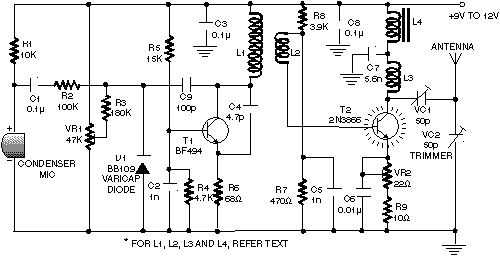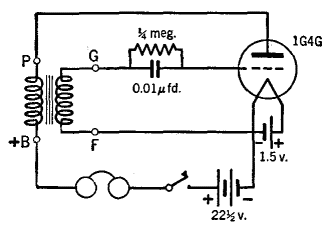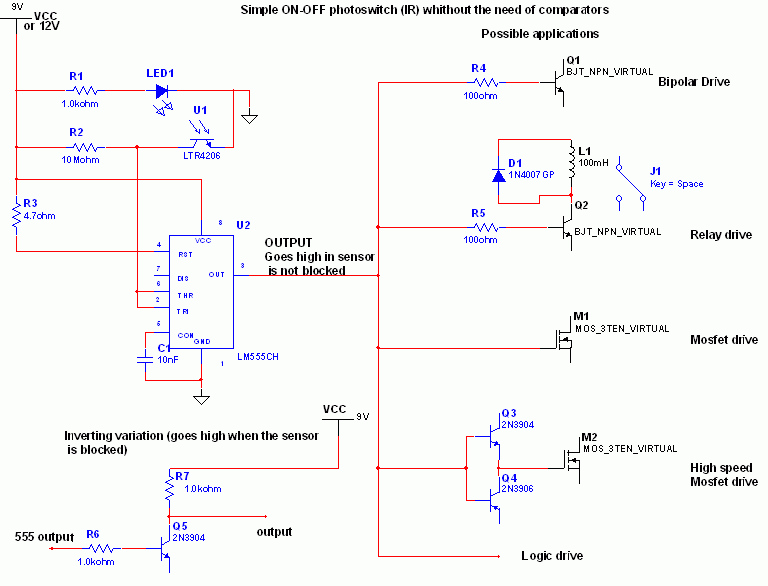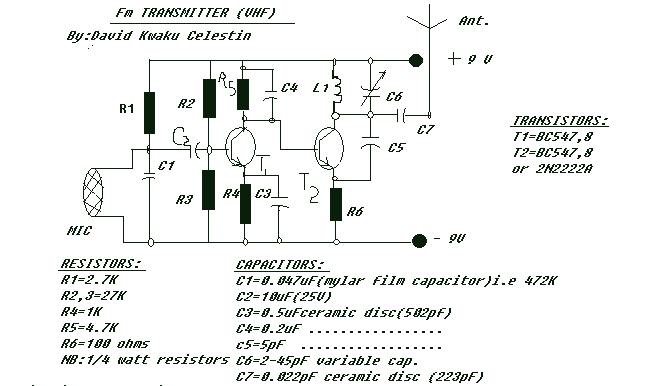
Simple FM Transmitter
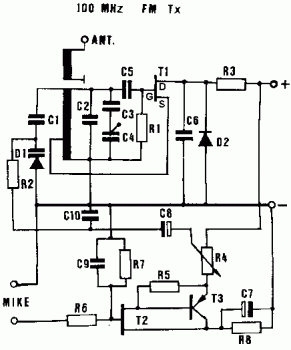
The frequency range is 100-108 MHz. The circuit is a mono circuit that accepts audio input from either a microphone or another source. The input impedance is 1 MΩ, with an input sensitivity of 5 mV and a maximum input signal of 10 mV. The transmitted signal can be received on an FM radio, making this circuit suitable for short-range transmission, such as for wireless microphones. The power supply required is 9-14 V DC, and a standard rectangular 9V battery is sufficient. This should be connected to the positive and negative points on the PCB. The audio input connects to the points labeled "MIKE," while the antenna should be connected to the point labeled "ANT." The emitter's output impedance is 50 ohms, and a custom antenna can be constructed if desired.
The circuit operates within the FM band, specifically designed for transmitting audio signals wirelessly. It features a mono audio input that can accept signals from various sources, including microphones, which makes it versatile for different applications. The input impedance of 1 MΩ ensures compatibility with most audio devices, allowing for seamless integration.
The sensitivity specifications indicate that the circuit can effectively amplify audio signals starting from as low as 5 mV, with a maximum input signal threshold of 10 mV. This range is particularly useful for capturing clear audio without distortion, making it suitable for applications where sound quality is paramount, such as in public speaking or performances.
The power supply requirement of 9-14 V DC allows for flexibility in power sourcing. Using a standard 9V battery simplifies the design and makes the circuit portable. The connections on the PCB are straightforward, with clear labeling for the audio input ("MIKE") and antenna ("ANT") to facilitate easy assembly and troubleshooting.
The output impedance of 50 ohms is standard for RF applications, ensuring that the circuit can effectively couple with various antenna designs. Users have the option to create custom antennas tailored to specific transmission ranges or environments, which can enhance the circuit's performance.
Overall, this circuit represents a compact and efficient solution for short-range FM audio transmission, suitable for various wireless applications. Careful attention to the design and assembly will yield a reliable and effective wireless microphone system.Frequency range is 100-108 MHz. The circuit is only mono circuit, and accepts an audio input from either a microphone or other source. The input impedance is 1Mohm. The input sensitivity is 5mV and the max input signal is 10mV. The transmitted signal can be picked up on a FM radio. The circuit can be used for short-range transmission, eg. for wir eless microphones. The power supply to use is 9-14 V DC, one of the little rectangular 9V batteries is fine. Connect this to the + and - points on the PCB. The sound input goes to the points marked "MIKE". The antenna should be connected to the point marked "ANT". The emitter`s output impedance is 50 ohms. You can make your own fancy antenna if you like. 🔗 External reference
The circuit operates within the FM band, specifically designed for transmitting audio signals wirelessly. It features a mono audio input that can accept signals from various sources, including microphones, which makes it versatile for different applications. The input impedance of 1 MΩ ensures compatibility with most audio devices, allowing for seamless integration.
The sensitivity specifications indicate that the circuit can effectively amplify audio signals starting from as low as 5 mV, with a maximum input signal threshold of 10 mV. This range is particularly useful for capturing clear audio without distortion, making it suitable for applications where sound quality is paramount, such as in public speaking or performances.
The power supply requirement of 9-14 V DC allows for flexibility in power sourcing. Using a standard 9V battery simplifies the design and makes the circuit portable. The connections on the PCB are straightforward, with clear labeling for the audio input ("MIKE") and antenna ("ANT") to facilitate easy assembly and troubleshooting.
The output impedance of 50 ohms is standard for RF applications, ensuring that the circuit can effectively couple with various antenna designs. Users have the option to create custom antennas tailored to specific transmission ranges or environments, which can enhance the circuit's performance.
Overall, this circuit represents a compact and efficient solution for short-range FM audio transmission, suitable for various wireless applications. Careful attention to the design and assembly will yield a reliable and effective wireless microphone system.Frequency range is 100-108 MHz. The circuit is only mono circuit, and accepts an audio input from either a microphone or other source. The input impedance is 1Mohm. The input sensitivity is 5mV and the max input signal is 10mV. The transmitted signal can be picked up on a FM radio. The circuit can be used for short-range transmission, eg. for wir eless microphones. The power supply to use is 9-14 V DC, one of the little rectangular 9V batteries is fine. Connect this to the + and - points on the PCB. The sound input goes to the points marked "MIKE". The antenna should be connected to the point marked "ANT". The emitter`s output impedance is 50 ohms. You can make your own fancy antenna if you like. 🔗 External reference

